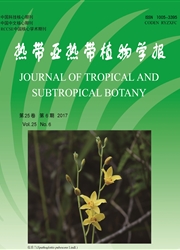

 中文摘要:
中文摘要:
采用平板法对香蕉(Musanana)植株的内生细菌进行分离纯化,并采用细菌脂肪酸法进行鉴定。结果表明,从香蕉的健康植株和感病植株中共分离得到内生细菌21属24种。从健株分离得到9种内生细菌,其中根、茎和叶分别分离到6种、2种和8种内生细菌。从病株分离得到15属17种内生细菌,其中根、茎和叶分别分离到3种、11种和6种。香蕉健株根部的内生细菌含量最高,达5.195×10^6cfug^-1,下部叶片内生细菌的含量最低,仅为30cfug^-1;香蕉病株茎部内生细菌的数量显著高于其他部位,达1.05×10^7cfug^-1。这说明香蕉在不同生长状态下,其内生细菌的种类和数量存在多样性。
 英文摘要:
英文摘要:
The endophytic bacteria in Musa nana collected from Zhangzhou in Fujian Province were isolated and identified by plate method. The results showed that there were 24 microbial species, belonging to 21 genera, isolated from Musa health and infected plants. Nine endophytic bacteria, belonging to 9 genera were contained from health plant, in which there were 6, 2 and 8 species isolated from root, stem and leaf, respectively. Seventeen endophytic bacteria, belonging to 15 genera were contained from infected plant, in which there were 11, 3 and 6 species isolated from stem, root and leaf, respectively. The content of endophytic bacteria in root of health plant was the highest, reached up to 5.195×10^6cfug^-1, while that in lower leaves was the lowest with 30 cfu g^-1. The content of endophytic bacteria in stem of infected plant was significant higher than those in other parts, accounting for 1.05 ×10^7cfug^-1. It suggested that endophytic bacterial species and content in Musa had diversity under different growth states.
 同期刊论文项目
同期刊论文项目
 同项目期刊论文
同项目期刊论文
 期刊信息
期刊信息
